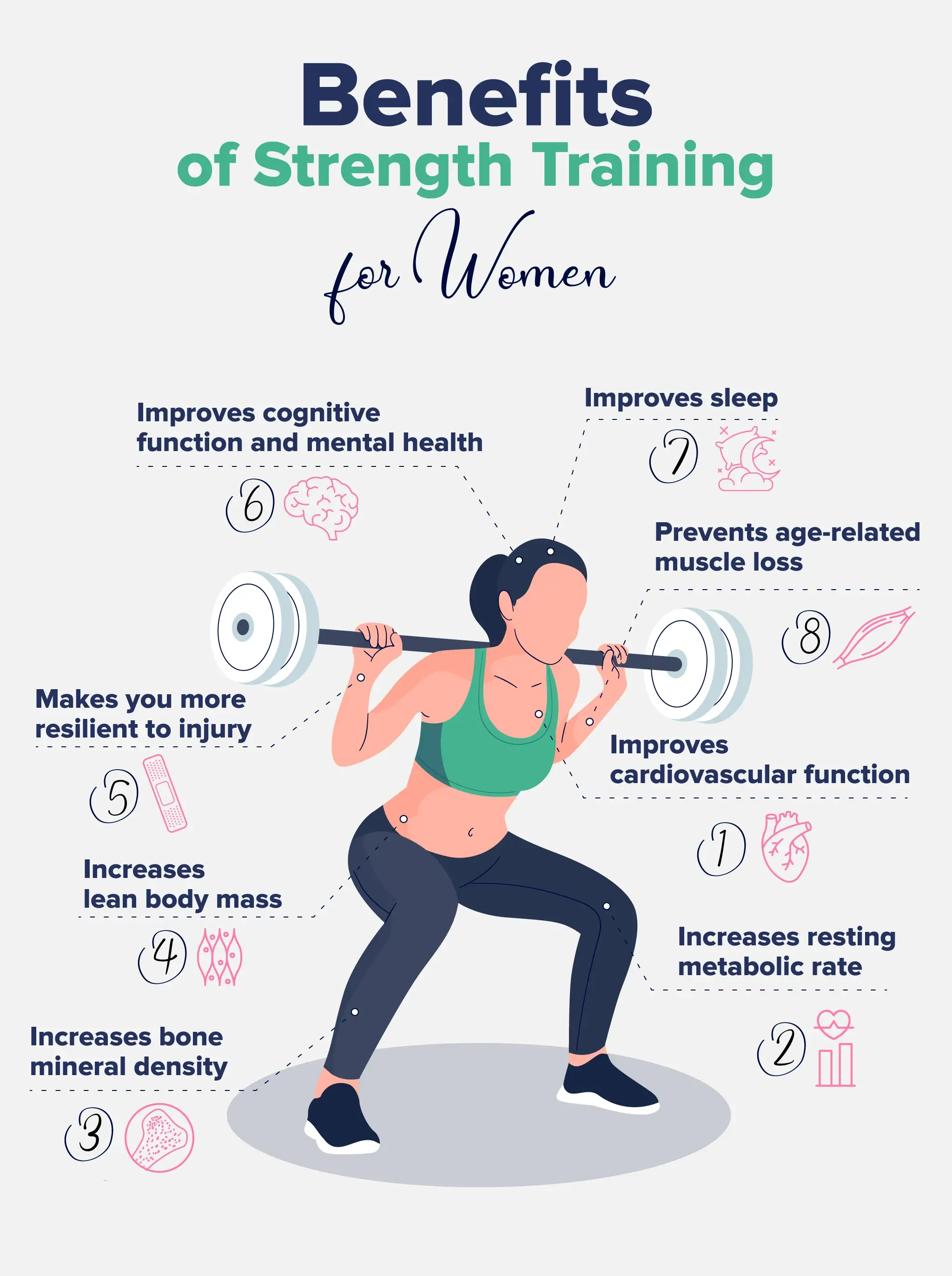This post contains links through which we may earn a small commission should you make a purchase from a brand. This in no way affects our ability to objectively critique the products and brands we review.
Benefits of Strength Training for Women
Evidence Based Research To fulfill our commitment to bringing our audience accurate and insightful content, our expert writers and medical reviewers rely on carefully curated research.
Read Our Editorial Policy
Contrary to popular belief, strength training isn’t just about building muscle to look good on the beach or become the next Mr. or Ms. Olympia.
Yes, it is true that strength training helps you gain muscle and lose fat at the same time. However, strength training—also known as weight training or resistance training—is certainly not all about losing weight.
It has tons of other health benefits, too.
Strength training can help both men and women improve their cardiovascular health, mental and cognitive health, and sleep quality.
While strength training may seem like more of a “guy thing,” adding strength training to their weekly routine would benefit many women as it can specifically increase bone density, helping to stave off osteoporosis and prevent injury later in life when we’re more prone to falls and accidents.
But that’s not all! There are many reasons women should take up strength training to improve their overall health and well-being.
So, let’s dive in and learn how becoming a “muscle mommy” might just improve your quality of life now and well into the future.

8 Reasons Women Should Strength Train
Okay, the whole muscle mommy thing is a little silly, but the world of strength training is not as weird and intimidating as it may seem—I promise.
And, again, it’s not all about muscle. There are actually many benefits to strength training that are less frequently talked about.
Here are just eight of the many health advantages you can expect to benefit from when you incorporate strength training into your routine.
1. Improves cardiovascular function
One of the tippity top benefits of resistance training has to be improved cardiovascular health, function, and performance.
This study shows that women who participate in strength training may reduce the risk of heart disease by 17% compared to women who do no strength training.1
This may be due to the overall reduction in heart disease risk factors. Studies have shown that women who perform resistance training can reduce high blood pressure, fasting glucose, total cholesterol, and body fat percentage.2
As a result, resistance training can also reduce your risk of type 2 diabetes.
And this isn’t just for older women! Women of all ages, health status, and activity levels can see cardiovascular benefits from resistance training.
2. Increases resting metabolic rate
A contributor or risk factor for overweight and obesity is a reduced resting metabolic rate (RMR). This is basically the amount of calories you burn at rest.3
As a result, if your RMR is low, then you’ll have a lower total daily energy expenditure (TDEE), which is essentially how many calories you burn in total with exercise and all daily activities (including digesting food).
One potential cause of lower RMR can be reduced skeletal muscle mass. So, even if you’re active and doing aerobic exercise, you may have a lower RMR if you don’t have much muscle mass.4
On average, women have a much lower percentage of skeletal muscle compared to men by about 30.6%, leading to lower RMR and TDEE. This is one potential reason why women can have more difficulty losing weight.5
However, hope is not lost! Women can increase their RMR and TDEE by increasing their skeletal muscle mass with resistance training.
Per this systematic review, with just two training sessions per week for the lower-body muscle groups and two or more for the upper-body, women can increase their strength and muscle mass and eventually see their RMR increase as well.6
This means you may need to consume more calories to maintain your current weight, or if weight loss is your goal, you will burn fat if you eat below your TDEE.
3. Increases bone mineral density
In general, women tend to have a lower bone mineral density (BMD) than men due to our comparatively smaller and thinner bones.
Then, as we age, our estrogen levels—which is one hormone that plays a factor in the health of our bones—decrease. This leads to a greater chance of osteoporosis, which is when bones become brittle and fragile.
This increases the chances of breaking bones, particularly hips, as we age. This can be extremely difficult to recover from at an advanced age.
However, strength training may prevent bone density loss—and even increase BMD—making this an incredible solution for women to utilize at all ages, especially as we grow older.7
While it’s best to start resistance training when you’re younger, it’s never too late to make it a part of your routine if you’re older.
In fact, this meta-analysis found that post-menopausal women can see increased bone mineral density in their lumbar spine, neck, and hips from moderate-intensity strength training three times a week.8
4. Increases lean body mass
As you may be able to surmise from the previous points, strength training is one of the most effective ways to build muscle mass, also called lean body mass or fat-free mass.
This is important since lean body mass is a significant indicator for many aspects of your health.
A higher ratio of lean body mass to visceral fat is associated with lower risks of all-cause mortality and specifically reduces the risk of cardiovascular disease and insulin resistance.9,10
Pro tip: If you’re regularly strength training and on a weight loss journey, your body weight may not change according to the scale since you are changing your body composition, i.e., increasing lean muscle mass as you burn fat.
So, try to base your progress on how your clothes fit, how you feel, and the changes you might notice in the mirror. This may also help you develop a healthier mindset around your weight.
5. Makes you more resilient to injury
While there is the potential to become injured when getting your reps in at the gym, strength training can actually help relieve pain and avoid injury both in sports and everyday life.
Whether you’re moving a couch, playing a pick-up game of soccer, lifting up your child, or walking your dog, there are tons of ways you can potentially injure yourself, especially if you’re mostly sedentary.
Though the benefits of resistance training for reducing injuries have mostly been studied in the context of sports injuries, the mechanisms that prevent injuries in normal, day-to-day life are the same.11
Essentially, since resistance training increases the strength of frequently used muscles, you won’t immediately throw your back out when you move furniture or get a sore shoulder if your dog decides to chase after a squirrel.12
Strength training can also increase the strength of ligaments and tendons and their connections to the bone, as well as joint cartilage and the connective tissue sheaths within the muscle.13
This is also why a physical therapist may prescribe training with resistance bands as a form of recovery. Strengthening those muscles and ligaments can help heal and prevent future injuries, too.
6. Improves cognitive function and mental health
There is increasing evidence that strength training supports both your physical and mental health.
When it comes to cognitive function, it’s shown that with regular resistance training and increased muscle mass, individuals can improve several aspects of their cognition, including:
- Global cognitive performance14
- Executive functions15,16
- Higher scores on standardized cognitive test batteries17
The mechanisms for how strength training and increased muscle mass equate to bigger brains are not yet fully understood, but there are a number of hypotheses.
One suggestion is that resistance exercises produce unique neurochemicals that trigger neurobiological processes that increase brain function.18 This is called the “neurotrophic hypothesis.”
There are also two other hypotheses within this review.19
The first is that strength training results in functional or structural brain changes that alter neuroelectrical potential, blood flow, brain connectivity, and metabolic processes within the brain.
The final hypothesis is that socioemotional changes, such as alterations in sleep, stress, mood, and pain, can also impact our cognitive performance.
On that last point, though it is just a hypothesis regarding cognitive function, there is good evidence that resistance training does positively affect our mental health, particularly depression and anxiety.20,21
So, not only can strength training make you healthier physically, it can make you happier, calmer, and smarter—talk about a quadruple whammy!
7. May help improve sleep
Getting good sleep is a cornerstone of health. It regulates your mood and memory, heart health, immune health, and even your hunger hormones.22,23,24,25
However, women may not be getting as high a quality of sleep as men due to hormonal fluctuations, higher incidence of insomnia, and higher rates of anxiety and depression.26,22
Finally, women may need more sleep than men. You can imagine this being a bit difficult considering the 9-5 lifestyle and other sociological pressures women typically face, such as childcare.27
So, we know sleep is extremely important and that women may not be getting enough of it, but how do we change that?
This systematic review of randomized controlled trials shows a strong positive correlation between strength training and improved sleep quality.28
If you were wondering how resistance training compares to aerobic training, so were these researchers.29 They carried out a 12-month study with 386 adults that compared aerobic training to resistance training and a third group that combined the two.
Here are some of the key findings:
- Resistance training had the highest increase in sleep time: Of the 42% of participants who were not getting at least 7 hours of sleep, individuals in the resistance exercise group were able to increase their sleep time by 40 minutes, compared to 23 minutes in the aerobic exercise group, about 17 minutes in the combined exercise group, and 15 minutes in the control group.
- Greater sleep efficiency: The resistance exercise and combined exercise groups saw greater sleep efficiency, or the percentage of time spent asleep while in bed, but not in the aerobic or no exercise group.
- Decreased sleep latency (onset of sleep): The resistance training group fell asleep 3 minutes sooner with no notable change in the other groups.
So, when it comes to weight training for women, this may just be the key to improving sleep quality and duration.
8. Prevents age-related muscle loss
As we age, we are prone to losing muscle mass—also called “sarcopenia”—due to changes in our hormones and our body’s ability to generate muscle protein cells.30
This process begins in our 30s or 40s but picks up in pace once we reach around 65 years of age. From that time onward, it’s estimated that we lose about 8% of our muscle mass each decade.
Even worse still, women have a harder time holding onto muscle compared to men due to having less muscle and more fat to begin with, increasing our chances of becoming frail in our 50s and 60s.31
But now that we know how important maintaining our muscle mass is for our health, we don’t want to lose it, right?
Well, the way to slow down this age-related muscle loss is the same process we may have taken to build it—resistance training.
Even if you haven’t done strength training most of your life, you can still pick up this exercise at an older age to regain or maintain strength and reap its benefits.
In a meta-analysis of the available literature on this topic, researchers found that elderly sarcopenia patients who weight train significantly improve muscle strength and muscle quality.32
However, the best type of training for this age group is moderate-intensity resistance training with a resistance band 3 times per week for more than 12 weeks, 40–60 minutes each session.
FAQs
How many days a week should a woman strength train?
The World Health Organization (WHO) recommends at least two days of resistance training per week.33 However, in an analysis of 31 studies (with data from a total of 621 subjects), researchers conclude that women will see the most strength gains performing weight lifting at least two times a week for the lower body and two to three times per week for the upper body.6 Additional evidence indicates middle-aged women would benefit from resistance training with free weights via larger training volumes of 6–8 sets per muscle group per week.34
How long does it take for women to see results from strength training?
When you start weight training, especially if you are a beginner, you may notice some small changes, such as visible muscle growth and increased strength, as early as three to four weeks after you begin a training program. With regular weight training, you will almost certainly see results within 12 weeks with larger gains in the upper body than the lower body.35 Regardless of your gender, though, the key to achieving your desired results is consistency.
What kind of strength training exercises should women do?
Grabbing dumbbells or loading weight plates onto a bar can be intimidating if it’s your first day in the gym, but strength training isn’t just lifting weights! There are tons of ways you can do strength training and still see great results. Most commercial gyms will have weight machines, cable machines, pre-weighted barbells, and resistance bands for members to use. You can also do bodyweight strength training workouts that use no equipment at all. If you’re looking to also lose weight with strength training, you should consider incorporating aerobic training into your regimen at least two to three times a week. These can be exercises you can do in the gym on a treadmill or machines or outside, such as walking, running, cycling, rowing, or the elliptical machines.
- Shiroma, E. J., Cook, N. R., Manson, J. E., Moorthy, M. V., Buring, J. E., Rimm, E. B., & Lee, I. M. (2017). Strength Training and the Risk of Type 2 Diabetes and Cardiovascular Disease. Medicine and science in sports and exercise, 49(1), 40–46. https://doi.org/10.1249/MSS.0000000000001063
- Drenowatz, C., Sui, X., Fritz, S., Lavie, C. J., Beattie, P. F., Church, T. S., & Blair, S. N. (2015). The association between resistance exercise and cardiovascular disease risk in women. Journal of science and medicine in sport, 18(6), 632–636. https://doi.org/10.1016/j.jsams.2014.09.009
- Astrup, A., Gøtzsche, P. C., van de Werken, K., Ranneries, C., Toubro, S., Raben, A., & Buemann, B. (1999). Meta-analysis of resting metabolic rate in formerly obese subjects. The American journal of clinical nutrition, 69(6), 1117–1122. https://doi.org/10.1093/ajcn/69.6.1117
- Phillips, S. M., & Winett, R. A. (2010). Uncomplicated resistance training and health-related outcomes: evidence for a public health mandate. Current sports medicine reports, 9(4), 208–213. https://doi.org/10.1249/JSR.0b013e3181e7da73
- Janssen, I., Heymsfield, S. B., Wang, Z. M., & Ross, R. (2000). Skeletal muscle mass and distribution in 468 men and women aged 18-88 yr. Journal of applied physiology (Bethesda, Md. : 1985), 89(1), 81–88. https://doi.org/10.1152/jappl.2000.89.1.81
- Jung, R., Gehlert, S., Geisler, S., Isenmann, E., Eyre, J., & Zinner, C. (2023). Muscle strength gains per week are higher in the lower-body than the upper-body in resistance training experienced healthy young women-A systematic review with meta-analysis. PloS one, 18(4), e0284216. https://doi.org/10.1371/journal.pone.0284216
- Massini, D. A., Nedog, F. H., de Oliveira, T. P., Almeida, T. A. F., Santana, C. A. A., Neiva, C. M., Macedo, A. G., Castro, E. A., Espada, M. C., Santos, F. J., & Pessôa Filho, D. M. (2022). The Effect of Resistance Training on Bone Mineral Density in Older Adults: A Systematic Review and Meta-Analysis. Healthcare (Basel, Switzerland), 10(6), 1129. https://doi.org/10.3390/healthcare10061129
- Wang, Z., Zan, X., Li, Y., Lu, Y., Xia, Y., & Pan, X. (2023). Comparative efficacy different resistance training protocols on bone mineral density in postmenopausal women: A systematic review and network meta-analysis. Frontiers in physiology, 14, 1105303. https://doi.org/10.3389/fphys.2023.1105303
- Lee, D. H., Keum, N., Hu, F. B., Orav, E. J., Rimm, E. B., Willett, W. C., & Giovannucci, E. L. (2018). Predicted lean body mass, fat mass, and all cause and cause specific mortality in men: prospective US cohort study. BMJ (Clinical research ed.), 362, k2575. https://doi.org/10.1136/bmj.k2575
- Shao, Y., Li, L., Zhong, H., Wang, X., Hua, Y., & Zhou, X. (2023). Anticipated correlation between lean body mass to visceral fat mass ratio and insulin resistance: NHANES 2011-2018. Frontiers in endocrinology, 14, 1232896. https://doi.org/10.3389/fendo.2023.1232896
- Lauersen, J. B., Bertelsen, D. M., & Andersen, L. B. (2014). The effectiveness of exercise interventions to prevent sports injuries: a systematic review and meta-analysis of randomised controlled trials. British journal of sports medicine, 48(11), 871–877. https://doi.org/10.1136/bjsports-2013-092538
- Lauersen, J. B., Andersen, T. E., & Andersen, L. B. (2018). Strength training as superior, dose-dependent and safe prevention of acute and overuse sports injuries: a systematic review, qualitative analysis and meta-analysis. British Journal of Sports Medicine, 52(24), 1557–1563. https://doi.org/10.1136/bjsports-2018-099078
- Fleck, S. J., & Falkel, J. E. (1986). Value of resistance training for the reduction of sports injuries. Sports medicine (Auckland, N.Z.), 3(1), 61–68. https://doi.org/10.2165/00007256-198603010-00006
- Mavros, Y., Gates, N., Wilson, G. C., Jain, N., Meiklejohn, J., Brodaty, H., Wen, W., Singh, N., Baune, B. T., Suo, C., Baker, M. K., Foroughi, N., Wang, Y., Sachdev, P. S., Valenzuela, M., & Fiatarone Singh, M. A. (2017). Mediation of Cognitive Function Improvements by Strength Gains After Resistance Training in Older Adults with Mild Cognitive Impairment: Outcomes of the Study of Mental and Resistance Training. Journal of the American Geriatrics Society, 65(3), 550–559. https://doi.org/10.1111/jgs.14542
- Forte, R., Boreham, C. A., Leite, J. C., De Vito, G., Brennan, L., Gibney, E. R., & Pesce, C. (2013). Enhancing cognitive functioning in the elderly: multicomponent vs resistance training. Clinical interventions in aging, 8, 19–27. https://doi.org/10.2147/CIA.S36514
- Chen, W. L., Peng, T. C., Sun, Y. S., Yang, H. F., Liaw, F. Y., Wu, L. W., Chang, Y. W., & Kao, T. W. (2015). Examining the Association Between Quadriceps Strength and Cognitive Performance in the Elderly. Medicine, 94(32), e1335. https://doi.org/10.1097/MD.0000000000001335
- Pentikäinen, H., Savonen, K., Komulainen, P., Kiviniemi, V., Paajanen, T., Kivipelto, M., Soininen, H., & Rauramaa, R. (2017). Muscle strength and cognition in ageing men and women: The DR’s EXTRA study. European Geriatric Medicine, 8(3), 275–277. https://doi.org/10.1016/j.eurger.2017.04.004
- Stimpson, N. J., Davison, G., & Javadi, A. H. (2018). Joggin’ the Noggin: Towards a Physiological Understanding of Exercise-Induced Cognitive Benefits. Neuroscience and biobehavioral reviews, 88, 177–186. https://doi.org/10.1016/j.neubiorev.2018.03.018
- Herold, F., Törpel, A., Schega, L., & Müller, N. G. (2019). Functional and/or structural brain changes in response to resistance exercises and resistance training lead to cognitive improvements – a systematic review. European review of aging and physical activity : official journal of the European Group for Research into Elderly and Physical Activity, 16, 10. https://doi.org/10.1186/s11556-019-0217-2
- Gordon, B. R., McDowell, C. P., Hallgren, M., Meyer, J. D., Lyons, M., & Herring, M. P. (2018). Association of Efficacy of Resistance Exercise Training With Depressive Symptoms: Meta-analysis and Meta-regression Analysis of Randomized Clinical Trials. JAMA psychiatry, 75(6), 566–576. https://doi.org/10.1001/jamapsychiatry.2018.0572
- Barahona-Fuentes, G., Huerta Ojeda, Á., & Chirosa-Ríos, L. (2021). Effects of Training with Different Modes of Strength Intervention on Psychosocial Disorders in Adolescents: A Systematic Review and Meta-Analysis. International journal of environmental research and public health, 18(18), 9477. https://doi.org/10.3390/ijerph18189477
- Glavin, E. E., Matthew, J. P., & Spaeth, A. M. (2021). Gender differences in the relationship between exercise, sleep, and mood in young adults. Health Education & Behavior, 49(1), 128–140. https://doi.org/10.1177/1090198120986782
- Sleep. (n.d.). www.heart.org. https://www.heart.org/en/healthy-living/healthy-lifestyle/sleep
- Garbarino, S., Lanteri, P., Bragazzi, N. L., Magnavita, N., & Scoditti, E. (2021). Role of sleep deprivation in immune-related disease risk and outcomes. Communications biology, 4(1), 1304. https://doi.org/10.1038/s42003-021-02825-4
- Greer, S. M., Goldstein, A. N., & Walker, M. P. (2013). The impact of sleep deprivation on food desire in the human brain. Nature communications, 4, 2259. https://doi.org/10.1038/ncomms3259
- Bryan, L., & Bryan, L. (2024, March 19). How is sleep different for men and women? Sleep Foundation. https://www.sleepfoundation.org/how-sleep-works/how-is-sleep-different-for-men-and-women
- Burgard, S. A., & Ailshire, J. A. (2013). Gender and Time for Sleep among U.S. Adults. American sociological review, 78(1), 51–69. https://doi.org/10.1177/0003122412472048
- Kovačević, A., Mavros, Y., Heisz, J. J., & Singh, M. a. F. (2018). The effect of resistance exercise on sleep: A systematic review of randomized controlled trials. Sleep Medicine Reviews, 39, 52–68. https://doi.org/10.1016/j.smrv.2017.07.002
- Resistance exercise may be superior to aerobic exercise for getting better ZZZs. (n.d.). American Heart Association. https://newsroom.heart.org/news/resistance-exercise-may-be-superior-to-aerobic-exercise-for-getting-better-zzzs
- Professional, C. C. M. (n.d.). Sarcopenia. Cleveland Clinic. https://my.clevelandclinic.org/health/diseases/23167-sarcopenia
- Duenke, K. (2016, January 13). Older women, not men, have a hard time maintaining muscle mass – The Source – Washington University in St. Louis. The Source. https://source.wustl.edu/2008/03/older-women-not-men-have-a-hard-time-maintaining-muscle-mass/
- Zhao, H., Cheng, R., Song, G., Teng, J., Shen, S., Fu, X., Yan, Y., & Liu, C. (2022). The Effect of Resistance Training on the Rehabilitation of Elderly Patients with Sarcopenia: A Meta-Analysis. International journal of environmental research and public health, 19(23), 15491. https://doi.org/10.3390/ijerph192315491
- World Health Organization. (2020). RECOMMENDATIONS. WHO Guidelines on Physical Activity and Sedentary Behaviour – NCBI Bookshelf. https://www.ncbi.nlm.nih.gov/books/NBK566046/
- Isenmann, E., Kaluza, D., Havers, T., Elbeshausen, A., Geisler, S., Hofmann, K., Flenker, U., Diel, P., & Gavanda, S. (2023). Resistance training alters body composition in middle-aged women depending on menopause – A 20-week control trial. BMC women’s health, 23(1), 526. https://doi.org/10.1186/s12905-023-02671-y
Abe, T., DeHoyos, D. V., Pollock, M. L., & Garzarella, L. (2000). Time course for strength and muscle thickness changes following upper and lower body resistance training in men and women. European journal of applied physiology, 81(3), 174–180. https://doi.org/10.1007/s004210050027








